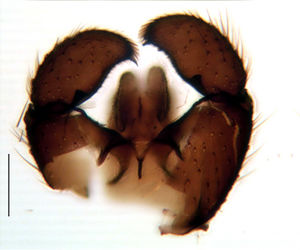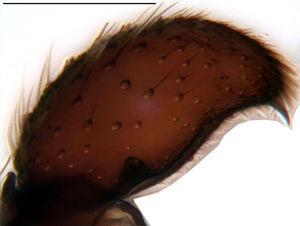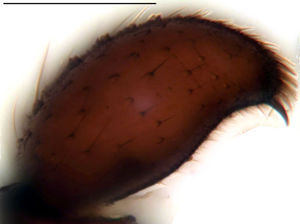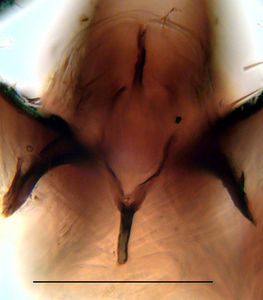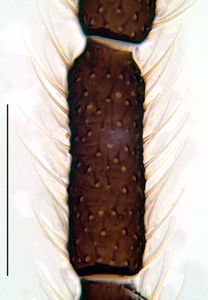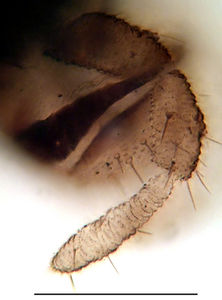Hirtipennia parcepilosa
Ordo: Diptera
Familia: Sciaridae
Genus: Hirtipennia
Name
Hirtipennia parcepilosa (Strobl, 1900) – Wikispecies link – ZooBank link
- Trichosia parcepilosa Strobl, 1900[1]: 650-651
- Leptosciarella (Hirtipennia) parcepilosa (Strobl, 1900)[2]: 48-49, fig. 4
- Trichosia quadristrigata Strobl, 1909[3]: 127
Type material
Holotype: ♂, May 1890, leg. Strobl, in NMBA
Type locality
Croatia, Monte Marian near Spalato
Material studied
Spain: 1 ♂, Retuerta de Pina b. Zaragoza, Juniperus thurifera forest, Malaise trap, Blasco-Zumeta, 23.11.1990, PKHH 3606.
Description (male)
Head. Eye bridge 3–4 rows of facets. Antennae unicolour. LW-index of 4th antennal flagellar segment 2.6–2.9; neck 0.35–0.45 of segment width; Transition of basal part to neck bottle-neck like. Colour of neck unicolour. Antennal hairs shorter than segment width, or as long as segment width; normal; sparse; salient. Palps darkened; normal; palpomeres 3. First palpomere of normal shape; with 4–5 bristles; with only some sparse sensillae. Second palpomere shortly oval. Third palpomere as long as first segment. Thorax. Colour brown. Notum unicolour. Thoracic setae normal; bright. Mesonotum with some weaker central bristles. Posterior pronotum bare, or setose. Postpronotal setae 0–2; fine. Mesothoracic sclerites bare. Legs. Colour yellow-brown. Hind coxae of same colour as femora. Hairs on fore coxae bright. Front tibia apically with a patch of setae. Front tibial organ bright. Front tibial organ not bordered. Tibial setae on hind legs normal, shorter than tibial width. Tibial spurs of equal length. Claws untoothed. Wings. Wings slightly darkened; of normal shape. Wing membrane partially with macrotrichia. Wing venation weak, with faint m-base. M-fork of normal shape. R1 inserting at or slightly before base of m-fork; posterior veins with macrotrichia; stM mainly with macrotrichia; cuA1 and cuA2 mainly with macrotrichia; bM bare; r-m mostly setose; bM:r-M 1.3–1.6; st-Cu:bM 0.2–0.3; r1:r 1.58–1.8; C:w 0.47–0.57. Halteres dark; of normal length. Abdomen. Abdominal setae strong and dense; dorsally white; ventrally white. Hypopygium concolour with abdomen; 0.55–0.71 × longer than wide. Base of gonocoxites with normal, weak hairs; gonocoxites fused; inner margin of gonocoxites normally U-shaped; inner membrane of hypopygium scarcely setose; elongated setae on valves of hypopygium absent. Gonostylus elongate; 1.8–2 × longer than wide; Inner margin concave; apex equally rounded. Apical tooth present; 3.2–3.62 × longer than broad; normal. Awl-like setae normal; on inner side of gonostyles absent. Megasetae on inner part of gonostylus absent. Whiplash-hair absent. Tegmen 0.8–1.05 × longer than broad; trapezoid; normal; Central process absent. Length of aedeagus/hypopygium 10–18 %; Aeadeagal apical structure present. Measurements. Body size 2.5–3 mm. Hind tibia 1.3–1.55 mm. Wing length 2.4–2.8 mm.
Diagnosis
Hirtipennia parcepilosa is a smaller, bright haired species of Hirtipennia. It is characterized by the not complete coverage of the wings with macrotrichia and can thereby be distinguished from other known species of the subgenus. The most similar species appears to be Hirtipennia tomentosa, which also has bright hairs and slender gonostyli but is larger, has darker legs and a shorter apical tooth at the gonostylus.
DNA Barcoding
The COI sequence is assigned to BIN BOLD:ADJ5975 (n=1, K2P: 7.72%).
Etymology
lat. parcus = spare, pilosus = hairy; making reference sparse trichiation of the wing membrane.
Ecology
Hirtipennia parcepilosa is mainly a Mediterranean species but occurs also in Central Europe.
Distribution
Croatia[1], Germany[2], Great Britain[4], Israel[2], Morocco[5], Spain[6], Spain Canary Islands[7], Turkey[8].
Images
|
References
- ↑ 1.0 1.1 Strobl, G. 1900: Dipterenfauna von Bosnien, Hercegovina und Dalmatien. Wissenschaftliche Mittheilungen aus Bosnien und der Hercegovina, 7(3), 552–670.
- ↑ 2.0 2.1 2.2 Mohrig, W.; Menzel, F. 1997: Revision der paläarktischen Arten von Trichosia Winnertz sensu Tuomikoski, 1960 (Diptera, Sciaridae). – Teil II. Gattungen Leptosciarella Tuomikoski, 1960 und Trichodapus gen. nov. Studia dipterologica, 4(1), 41–98.
- ↑ Czerny, L.; Strobl, G. 1909: Spanische Dipteren. III. Beitrag. Verhandlungen der kaiserlich-königlichen zoologisch-botanischen Gesellschaft in Wien, 59(3-4), 121–301.
- ↑ Menzel, F.; Smith, J.E.; Chandler, P. 2006: The sciarid fauna of the British Isles (Diptera: Sciaridae), including descriptions of six new species. Zoological Journal of the Linnean Society, 146, 1-147. PDF
- ↑ El Ouazzani, N.E.H.; Heller, K.; Kettani, K. 2019: The first checklist of black fungus gnats (Diptera: Sciaridae) of Morocco. Annales de la Société entomologique de France (N.S.), 55(3), 274–290. doi: 10.1080/00379271.2019.1570826.
- ↑ Mohrig, W.; Blasco-Zumeta, J. 1996: The sciarid fauna (Diptera, Sciaridae) of a Juniperus thurifera L. forest of the Monegros region (Zaragoza, Spain) with description of ten new species. Miscellania Zoologica (Barcelona), 18, 99–116.
- ↑ Menzel, F.; Mohrig, W.; Báez, M. 1997: Die Trauermücken-Fauna der Kanarischen Inseln, unter Berücksichtigung der von Richard Frey beschriebenen Arten (Insecta: Diptera, Sciaridae). Vieraea, 25, 133–146.
- ↑ Rulik, B.; Röschmann, F.; Mohrig, W. 1999: New Species of Sciarid Flies (Diptera, Sciaridae) from Greece and Turkey. Journal of the Entomological Research Society, 1(3), 21–50.

